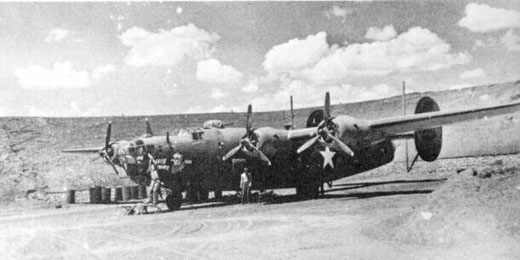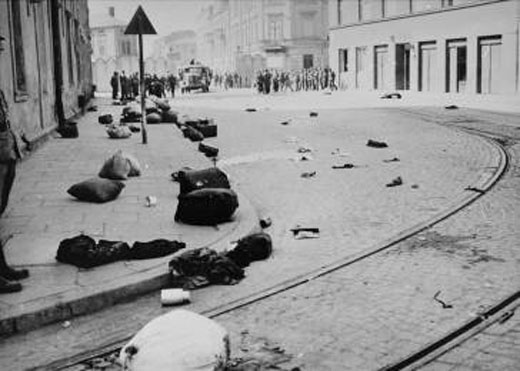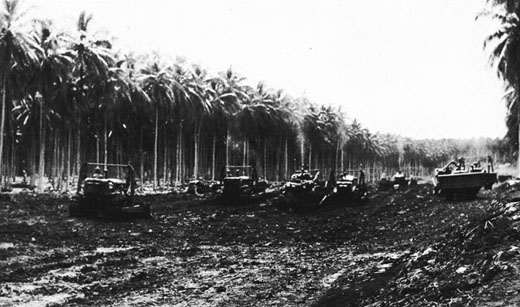Air Operations, Aleutians
12 Amchitka-based 54th Fighter Squadron P-40s and 3 P-38s bomb and strafe Kiska in separate attacks.
[Air Operations, Bismarcks
A B-17 from the 43rd Heavy Bomb Group attacks the Gasmata airfield on New Britain and warehouses at Wide Bay.
[Air Operations, CBI
BURMA4 7th Heavy Bomb Group B-24s attack a bridge at Pazundaung.
[Air Operations, Europe
BOMBER COMMANDEvening Ops:
- 51 Wellingtons and 17 Lancasters lay mines between Lorient and the Kattegat.
- 2 Wellingtons and 1 Lancaster are lost.
First Plane to Leave Salina |
 |
Air Operations, New Guinea
- 43rd Heavy Bomb Group B-17s attack the airfield and shipping at Wewak.
- 1 B-24 from the 90th Heavy Bomb Group attacks shipping off eastern New Guinea.
Air Operations, Solomons
XIII Bomber Command B-24s escorted by XIII Fighter Command P-38s and P-40s and VMF-124 F4Us attack the Vila airfield on Kolombangara and the Munda Point airfield on New Georgia and Faisi. During an interception by 50 A6M Zeros, 2 B-24s, all 4 P-38s, 2 F4Us, and 2 P-40s are lost.
[Air Operations, Tunisia
- NATAF and IX Fighter Group fighters attack German Army positions along the Mareth Line.
- In a long, running engagement centered on Gabes, 57th Fighter Group P-40 pilots down 4 Bf-109s and damage 5 or 6 others between 1405 and 1505 hours.
- An 81st Fighter Group P-39 pilot downs a Bf-109 over La Fauconnerie at 1755 hours, that unit's first victory of the war.
CBI
CHINAThe Chinese counterattack in the Yangtze Valley and push the Japanese across the Yangtze River.
[Battle of the Atlantic
- Returning from patrol, U-163 runs into an escort for convoy MKS-9 and is depth-charged and sunk by Canadian destroyer HCMS Prescott.
- U-68 attacks the Aruba bound Convoy GAT-49 and torpedoes the US tanker Cities Service Missouri (6506t). The US destroyer Biddle (DD-151) rescues survivors including the 11-man Armed Guard.
| Class | Type IXC |
| CO | Korvettenkapitän Kurt Engelmann |
| Location | Bay of Biscay |
| Cause | Depth charge |
| Casualties | 57 |
| Survivors | None |
Eastern Front
Violent fighting continues as the Germans attack the Russian defenders holding Kharkov.
Hitler issues the preliminary orders for Operation ZITADELLE (CITADEL), the attempted elimination of the Kursk Salient. (see July 5, 1943).
SOUTHERN SECTORThe Grossdeutschland Division forces a way into the junction of the 69th and 40th Armies and secures Borisovka. The Stavka reinforces the 69th Army with a tank corps.
SS Totenkopf severs the 3rd Tank Army lines of communication, isolating the already shattered army inside Kharkov. The severity of the fighting has considerably reduced the combat strength of the SS corp, Leibstandarte SS Adolf Hitler Division having only 14 operational panzers left. In all the battle inside the city has cost the Germans 11,500 killed.
[Mediterranean
U-172 torpedoes the US freighter Keystone (5565t), straggling from Convoy UGS-6, killing 1 of the crew and 1 Armed Guard sailor. The Portuguese steamship Sines rescues the survivors.
[New Guinea
Kanga Force continues to press the enemy back inch by inch toward Mubo and is now north of Guadagasel.
[North Africa
TUNISIAThe 18th Army Group sets March 17 as D-Day for the US II Corps' offensive, with the initial objective being Gafsa. The 1st Armored Div, reinforced by the 60th Regimental Combat Team of the 9th Div, begins movement from the Tébessa area, where it has been refitting since February 26th, toward the assembly area northeast of Gafsa. Elements are formed into a task force under Col Clarence C. Benson for detached service and move to a region southwest of Sbeïtla during the night. In preparation for the offensive, air operations are begun against enemy landing fields, although weather conditions are unfavorable.
[Occupied Poland
The Germans begin the liquidation of the Krakow Ghetto. The ghetto is divided into tow parts: Ghetto A for workers and Ghetto B for non-workers. Ghetto A is liquidated today, with all its workers being sent to Plaszow concentration camp. The action is led by SS-Untersturmführer Amon Göth, the new commandant of Plaszow. The SS will liquidate Ghetto B tomorrow, many people being killed in courtyards or in the streets. Since its creation the ghetto has held 20,000 Jews.
Liquidation of the Krakow Ghetto |
 |
Pacific
- The US submarine Grayback (SS-208) damages the Japanese transport Noshiro Maru 100 miles northwest of the Bismarck Archipelago.
- The US submarine Sunfish sinks the Japanese merchant cargo ship Kosei Maru (3262t) near Tokara Jima, Ryukyus.
- The Dutch submarine O-21 sinks the Japanese cargo ship Kasuga Maru (3967t) off Port Blair, Andaman Islands.
Secret War
The first of two attempts to kill Hitler within the span of a few days fails. Gen Henning von Tresckow, Field Marshal Hans Günther von Kluge;s chief of staff, and an aide plant a time-bomb aboard Hitler's personal aircraft at Smolensk. The device, make of plastic explosives, is contained in a package supposedly containing two bottles of brandy for delivery to a member of Hitler's staff at Wolfsschanze, Hitler's military headquarters in East Prussia. The detonator failed, as the conspirators discover when they recover the bomb.
The Smolensk Plot, an attempt to assassinate Hitler, was organized by Gen von Tresckow, a Prussian officer who fought with distinction in Poland and France, but who became convinced that Germany would face ruin in the war with Soviet Russia. The plan, involving Gördeler, Tresckow, Gen Friedrich Olbricht and Fabian von Schlabrendorff, was for Hitler to be enticed to army headquarters in the Smolensk area, where Tresckow was serving, and there murdered. In the event it was decided to place two bombs, disguised in a parcel to look like bottles of brandy, on the F¨hrer's plane. But technical problems with the bombs meant that the conspirators waited in vain for news of the explosion. When Hitler landed safely at Rastenburg the bombs were removed by Schlabrendorff and a new date was fixed, a week later, for another attempt, this time a the memorial day for World War I heroes at the Zeughaus in Berlin.
[ 33rd Seabees Working on Banika Airfield |
 |